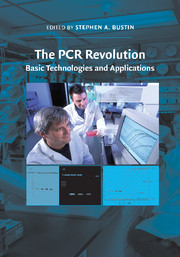Book contents
- Frontmatter
- Contents
- Contributors
- Foreword by Russell Higuchi
- Preface
- I BASIC TECHNOLOGIES
- II APPLICATIONS
- 10 Polymerase chain reaction–based methods for the detection of solid tumor cancer cells for clinical diagnostic and prognostic assays
- 11 Polymerase chain reaction and infectious diseases
- 12 Polymerase chain reaction and respiratory viruses
- 13 Polymerase chain reaction and severe acute respiratory syndrome
- 14 The MMR vaccine, measles virus, and autism – A cautionary tale
- 15 Noninvasive prenatal diagnosis using cell-free fetal nucleic acids in maternal plasma
- 16 Polymerase chain reaction–based analyses of nucleic acids from archival material
- 17 Microarrays and quantitative real-time reverse transcriptase–polymerase chain reaction
- 18 Polymerase chain reaction in the detection of genetic variation
- 19 Polymerase chain reaction: A blessing and a curse for ancient deoxyribonucleic acid research
- Index
- Plate section
- References
19 - Polymerase chain reaction: A blessing and a curse for ancient deoxyribonucleic acid research
Published online by Cambridge University Press: 25 January 2011
- Frontmatter
- Contents
- Contributors
- Foreword by Russell Higuchi
- Preface
- I BASIC TECHNOLOGIES
- II APPLICATIONS
- 10 Polymerase chain reaction–based methods for the detection of solid tumor cancer cells for clinical diagnostic and prognostic assays
- 11 Polymerase chain reaction and infectious diseases
- 12 Polymerase chain reaction and respiratory viruses
- 13 Polymerase chain reaction and severe acute respiratory syndrome
- 14 The MMR vaccine, measles virus, and autism – A cautionary tale
- 15 Noninvasive prenatal diagnosis using cell-free fetal nucleic acids in maternal plasma
- 16 Polymerase chain reaction–based analyses of nucleic acids from archival material
- 17 Microarrays and quantitative real-time reverse transcriptase–polymerase chain reaction
- 18 Polymerase chain reaction in the detection of genetic variation
- 19 Polymerase chain reaction: A blessing and a curse for ancient deoxyribonucleic acid research
- Index
- Plate section
- References
Summary
The analysis and use of ancient deoxyribonucleic acid (DNA) is intimately linked with the polymerase chain reaction (PCR). Although the first ancient DNA sequences were uncovered before the invention of PCR, ancient DNA research, like many other fields in molecular biology, only began to develop after this technique became established. From initial short fragments that could be amplified via PCR, ancient DNA research has evolved into a field in which complete mitochondrial genomes and genomic shotgun sequences of several megabases can be amplified and analyzed using modern variations of PCR, such as multiplex or emulsion PCR. These achievements became possible by PCR's extraordinary sensitivity, which allows amplification from as little as a single target molecule. However, this sensitivity has a dark side, because PCR also frequently amplifies contaminating DNA. Consequently, spectacular errors, such as the presumed amplification of several-million-year-old dinosaur DNA from bone or insect DNA from amber fossils, have plagued the field almost from its beginnings. In this chapter, we explore how PCR has been a blessing for the advancement of ancient DNA research, while also addressing its limitations, which seem much like a curse.
HISTORY OF ANCIENT DNA AND PCR
Ancient DNA research started more than twenty years ago, with the sequencing of two short mitochondrial DNA (mtDNA) fragments from the extinct quagga. This sequencing was achieved even in the absence of PCR; the first article to describe PCR was published almost exactly one year later.
- Type
- Chapter
- Information
- The PCR RevolutionBasic Technologies and Applications, pp. 284 - 300Publisher: Cambridge University PressPrint publication year: 2009
References
- 1
- Cited by



